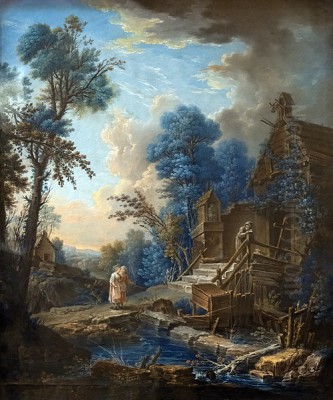
Pierre-Jacques Volaire, a name perhaps not as universally recognized as some of his contemporaries, nonetheless carved a unique and fiery niche for himself in the annals of 18th-century European art. A French painter who found his true calling under the shadow of Mount Vesuvius, Volaire became the preeminent visual chronicler of its spectacular and terrifying eruptions. His canvases, often depicting the dramatic interplay of molten lava, billowing smoke, and the ethereal glow of the moon, captured the essence of the Sublime – that potent mixture of awe, beauty, and terror that so fascinated the Romantic imagination. This exploration delves into the life, work, and artistic milieu of a painter who dared to gaze into the volcano's fiery heart and translate its raw power onto canvas.
Early Life and Artistic Genesis in Toulouse
Pierre-Jacques Volaire was born in 1729 in Toulouse, a vibrant city in southern France with a rich artistic heritage. His immersion in the world of art was almost preordained, as he hailed from a family deeply entrenched in artistic pursuits. His grandfather, Jean Volaire, was a painter known for decorating naval vessels and creating religious works, indicating a versatility that perhaps influenced the younger Volaire. His father, Jacques Volaire, held the respected position of official painter in Toulouse, further cementing the family's artistic standing. Even his mother, Marie-Anne, was a painter, contributing to an environment where artistic skill was nurtured and valued.
This familial background undoubtedly provided Pierre-Jacques with his initial exposure to artistic techniques and sensibilities. Growing up surrounded by painters, he would have had early access to materials, instruction, and, crucially, an understanding of the life of an artist. While specific details of his earliest training are sparse, it is reasonable to assume he learned the fundamentals from his father and grandfather. His early professional endeavors included restoration work, a task that requires a keen eye and a steady hand. In 1755, he is recorded as being engaged in restoration work at the Toulouse Cathedral, an experience that would have deepened his understanding of historical painting techniques and composition.
The Formative Years with Joseph Vernet
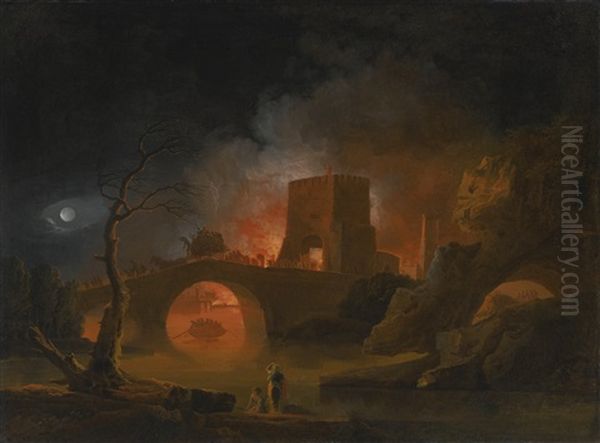
A pivotal moment in Volaire's early career came between 1754 and 1755, when he became an assistant to Claude-Joseph Vernet (often referred to simply as Joseph Vernet). Vernet was already a highly acclaimed landscape painter, particularly renowned for his series of French seaports commissioned by King Louis XV, and his dramatic seascapes and coastal scenes. This association, which some sources suggest lasted for as long as eight years until around 1762, was profoundly influential for Volaire.
Working alongside a master like Vernet provided Volaire with invaluable training. He absorbed Vernet's keen observational skills, learning to meticulously study and render the nuances of light, atmosphere, and natural phenomena. Vernet's lively and fluid technique, his careful attention to design, and his masterful handling of illumination all left an indelible mark on his young assistant. Volaire proved to be an adept student, eventually being recognized as one of Vernet's most creative and successful followers. He not only emulated his master's style but also demonstrated an ability to adapt these lessons to evolving aesthetic standards, foreshadowing his later, more personal artistic expressions. The collaboration on the French ports series, even if Volaire's role was sometimes described as more mechanical, would have exposed him to grand-scale compositions and the depiction of varied human activity within expansive landscapes.
The Italian Sojourn: Rome and the Call of Naples
Like many artists of his era, Volaire was drawn to Italy, the cradle of classical art and a vital destination for any aspiring painter. The Grand Tour was in full swing, and Italy, with its ancient ruins, Renaissance masterpieces, and stunning landscapes, offered unparalleled inspiration. While the exact date of his arrival in Italy is not precisely fixed, he spent time in Rome, the artistic epicenter, further honing his skills and absorbing the influences of both classical antiquity and the works of Italian masters. Rome offered a rich tapestry of artistic styles, from the classical landscapes of Claude Lorrain and Nicolas Poussin to the more dramatic and picturesque scenes of Salvator Rosa and Giovanni Paolo Panini.
However, it was not Rome but the southern city of Naples that would truly define Volaire's mature career. In 1769, he made the decisive move from Rome to Naples. This city, vibrant, chaotic, and dramatically situated on a beautiful bay, lived under the constant, looming presence of Mount Vesuvius. The volcano was not merely a scenic backdrop; it was an active, unpredictable force of nature, prone to frequent and spectacular eruptions. This fiery spectacle captivated the imaginations of locals and the increasing number of Grand Tourists alike, and for Volaire, it presented an irresistible artistic subject.
Capturing the Inferno: Volaire and the Eruptions of Vesuvius
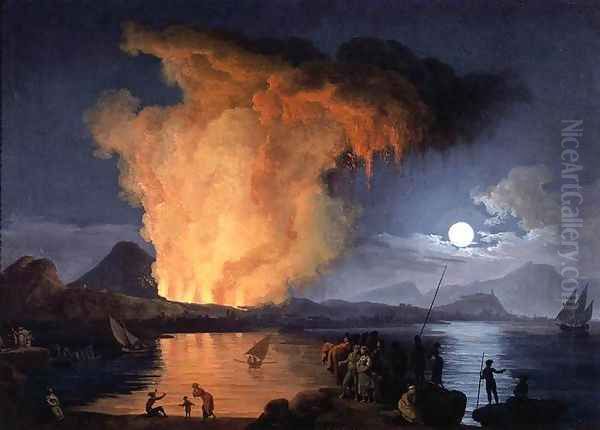
Upon settling in Naples, Volaire dedicated himself almost exclusively to depicting Mount Vesuvius, particularly its awe-inspiring eruptions. This thematic focus became his signature, and his paintings of the volcano gained him considerable fame. He was not the only artist to paint Vesuvius – figures like Pietro Fabris were also active in this genre – but Volaire brought a particular dramatic intensity and atmospheric brilliance to his portrayals.
His Vesuvius paintings are celebrated for their striking night scenes, where the cool, silvery light of the moon contrasts dramatically with the incandescent reds, oranges, and yellows of flowing lava and ejected volcanic matter. This juxtaposition of cool and warm light sources created a powerful visual tension and heightened the sublime horror of the event. Volaire masterfully rendered the textures of molten rock, the billowing clouds of ash and smoke that obscured the stars, and the terrified or awestruck human figures often silhouetted against the fiery backdrop. These small figures – often tourists, scientists, or fleeing locals – served to emphasize the immense scale and overwhelming power of the volcano, a common trope in depictions of the Sublime.
Among his most famous works in this genre are multiple canvases titled Eruption of Mount Vesuvius and specific scenes like The Eruption of Mount Vesuvius from the Atrio del Cavallo. These paintings were not mere topographical records; they were carefully composed dramas designed to evoke strong emotional responses in the viewer. He captured the terrifying beauty of the eruptions, the incandescent rivers of lava carving paths of destruction, and the explosive bursts lighting up the night sky. His meticulous attention to detail, likely honed during his time with Vernet, allowed him to render these cataclysmic events with a convincing, almost visceral realism, even as he amplified their dramatic impact.
Artistic Style: Romanticism, Light, and Atmosphere
Pierre-Jacques Volaire's artistic style is firmly rooted in the burgeoning Romantic movement, though it also shows the clear influence of his predecessors and contemporaries. His work successfully blended the dramatic, often wild, landscapes of Salvator Rosa with the more ordered, atmospherically sensitive approach of his mentor, Joseph Vernet. From Rosa, he inherited a taste for the untamed and the awe-inspiring aspects of nature, while Vernet's influence is evident in his sophisticated handling of light and his ability to create a palpable sense of atmosphere.
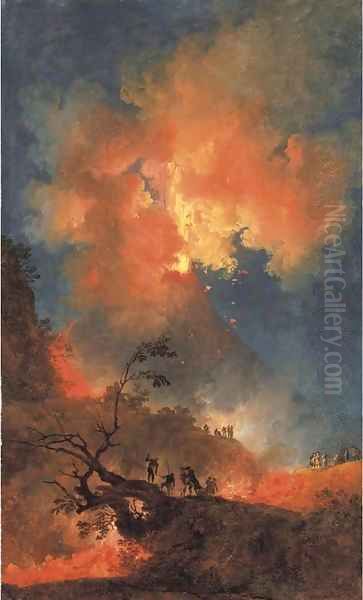
A hallmark of Volaire's style is his treatment of "atmospheric vibration" and the delicacy of his skies, whether they are illuminated by the moon, obscured by volcanic smoke, or glowing with the reflected light of an eruption. His figures, though often small in scale compared to the landscape, are rendered with vivacity. Riders, soldiers, curious children, and their horses populate his scenes, adding a human element to the grandeur of nature. These figures are not merely staffage; they often play a crucial role in conveying the narrative and emotional tone of the painting, reacting to the events unfolding around them.
While Vesuvius was his dominant theme, Volaire also produced other landscapes and night scenes, such as A Moonlit River Landscape With Figures Fleeing A Burning City. This work, like his volcanic scenes, showcases his mastery of nocturnal effects, his ability to create mood through light and shadow, and his Romantic preoccupation with dramatic events and human emotional responses. His palette, particularly in the Vesuvius paintings, was characterized by strong contrasts – the deep blues and greys of the night sky against the fiery oranges and reds of the lava – which enhanced the visual drama.
The scientific curiosity of the Enlightenment also played a role. Volaire's depictions of volcanic activity, while artistically heightened, were also observed with a degree of accuracy that made them valuable to contemporary scientists and vulcanologists. His paintings served not only as dramatic artworks but also as visual documents that fueled the growing interest in understanding the Earth's geological forces. This dual appeal to both artistic sensibility and scientific inquiry contributed to their popularity among the diverse audience of Grand Tourists, collectors, and scholars.
Contemporaries and the Neapolitan Artistic Milieu
During his time in Naples, Volaire was part of a lively artistic community, which included both Italian and foreign artists drawn to the city's unique charms and dramatic scenery. He is known to have had close contact with other painters specializing in Neapolitan views and volcanic scenes. Among these was Pietro Fabris, a painter of Italian or German origin, also known for his depictions of Vesuvius and Neapolitan life. Fabris, who sometimes anglicized his name to Peter Fabris, was patronized by Sir William Hamilton, the British envoy to Naples and an avid vulcanologist. It is recorded that Fabris occasionally resold Volaire's works, sometimes even to prominent figures like King Ferdinand IV of Naples, indicating a professional relationship that might have included both collaboration and friendly rivalry.
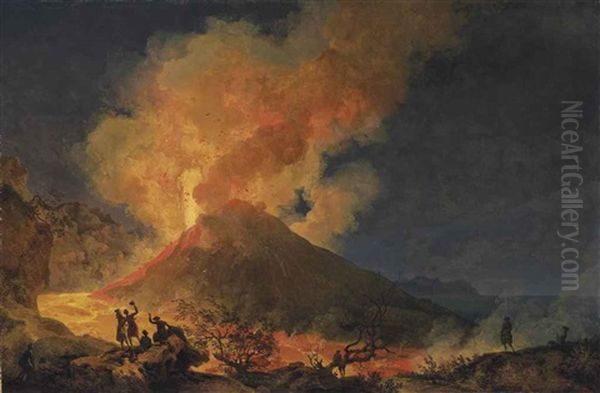
Another contemporary in Naples was Antonio Joli, a painter of vedute (highly detailed cityscapes or landscapes) who had worked in Venice with Canaletto and later in London and Madrid before settling in Naples. Joli's more panoramic and often sunnier depictions of the Bay of Naples and its surroundings would have offered a contrast to Volaire's dramatic, often nocturnal, volcanic scenes. The artistic environment in Naples was also enriched by the presence of numerous visiting artists from across Europe, such as Jacob Philipp Hackert, a German landscape painter who also worked extensively in Naples and was a favorite of the Neapolitan court.
Beyond Naples, Volaire's work can be situated within the broader European landscape tradition. His dramatic flair connects him to the aforementioned Salvator Rosa, but also to later artists who embraced the Sublime, such as Philippe Jacques de Loutherbourg, who also painted dramatic scenes of fire and disaster in England. While Volaire predates the full flowering of High Romanticism seen in artists like J.M.W. Turner (who himself painted Vesuvius) or Caspar David Friedrich, his work clearly anticipates their emotional intensity and focus on the power of nature. His lineage can also be traced back to the classical landscapes of Claude Lorrain, whose idealized Italian scenes set a standard for landscape painting, albeit with a more serene temperament than Volaire's fiery visions. Other landscape painters whose work provides context include Hubert Robert, known for his picturesque ruins, and Richard Wilson, a Welsh pioneer of landscape painting who was deeply influenced by his time in Italy.
Exhibitions, Reception, and Anecdotes
Volaire's dramatic paintings of Vesuvius found a ready market among the wealthy Grand Tourists who flocked to Naples, eager for spectacular souvenirs of their travels. His works were not only popular in Italy but also began to circulate more widely across Europe through exhibitions and private collections. He is known to have exhibited his works in the prestigious Paris Salons, for instance, in 1779 and 1786. While some accounts suggest his works might have occasionally been overlooked or even misattributed if signed by other, perhaps more established, French academicians at the time, his talent and unique specialization generally ensured recognition.
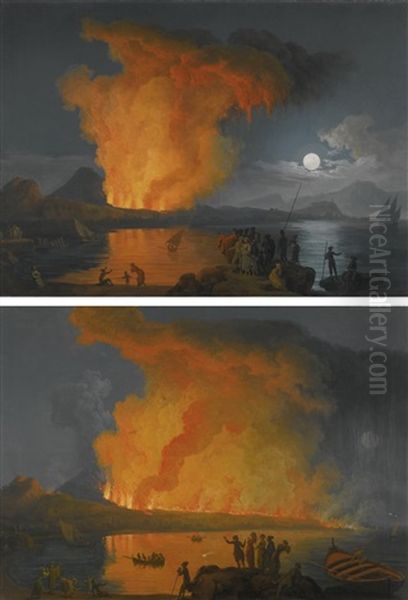
An interesting anecdote, though its precise veracity can be debated, concerns an attempt by Volaire to sell one of his Eruption of Mount Vesuvius paintings to King Louis XVI of France. According to this story, the painting was rejected, deemed too shocking, too violent, or perhaps simply too "indecent" in its raw depiction of natural fury for the refined tastes of the French court at that particular moment. If true, this incident highlights the challenging nature of Volaire's subject matter, which pushed the boundaries of conventional landscape painting and embraced the more unsettling aspects of the Sublime. It also underscores the differing tastes between the more adventurous collectors on the Grand Tour and the more conservative official art circles in Paris.
Despite such potential setbacks, Volaire's reputation as the foremost painter of Vesuvius was firmly established. His ability to capture both the visual spectacle and the emotional impact of the eruptions resonated with the spirit of the age, which was increasingly fascinated by the wild, untamed aspects of nature and the powerful emotions they could evoke. His paintings became iconic representations of Vesuvius, influencing how the volcano was perceived and imagined by a wider European audience.
Later Years and Enduring Legacy
Pierre-Jacques Volaire continued to live and work in Naples, the city that had provided him with his most potent inspiration. He remained dedicated to his volcanic theme, producing numerous variations and new depictions of Vesuvius's activity throughout his career. He passed away in Naples in 1799, at the age of seventy, leaving behind a significant body of work that continues to fascinate.
Today, Volaire's paintings are held in numerous prestigious museums and private collections around the world. Institutions such as the Art Institute of Chicago, the North Carolina Museum of Art, and various museums in France and Italy prize his dramatic canvases. His work is recognized for its artistic merit, its contribution to the Romantic movement, and its unique documentation of one of Europe's most famous and formidable natural wonders.
The legacy of Pierre-Jacques Volaire is that of an artist who found his definitive subject in the fiery eruptions of Mount Vesuvius. He was more than just a topographical painter; he was a poet of the inferno, a master of light and shadow who could convey the terrifying grandeur of nature unleashed. His paintings offer a window into the 18th-century fascination with the Sublime, and they remain powerful testaments to the enduring human awe in the face of nature's most dramatic spectacles. He successfully translated the raw, elemental power of a volcano into compelling works of art, securing his place as a distinctive and important figure in the landscape painting tradition of his era. His vivid portrayals of Vesuvius continue to captivate viewers, reminding us of the dramatic beauty and inherent danger that characterized the Neapolitan landscape and the artistic imagination of the late 18th century.